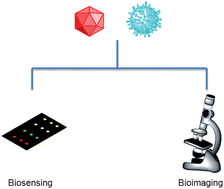Viruses and their potential in bioimaging and biosensing applications
Abstract
Successful development of ultrasensitive

* Corresponding authors
a State Key Laboratory of Fine Chemicals, Dalian University of Technology (DUT), Dalian 116012, P. R. China
b
Department of Chemistry and Biochemistry and Nanocenter, University of South Carolina, Columbia, SC, USA
E-mail:
wang@mail.chem.sc.edu
Tel: +1-803-777-8436
Successful development of ultrasensitive

 Please wait while we load your content...
Something went wrong. Try again?
Please wait while we load your content...
Something went wrong. Try again?
K. Li, H. G. Nguyen, X. Lu and Q. Wang, Analyst, 2010, 135, 21 DOI: 10.1039/B911883G
To request permission to reproduce material from this article, please go to the Copyright Clearance Center request page.
If you are an author contributing to an RSC publication, you do not need to request permission provided correct acknowledgement is given.
If you are the author of this article, you do not need to request permission to reproduce figures and diagrams provided correct acknowledgement is given. If you want to reproduce the whole article in a third-party publication (excluding your thesis/dissertation for which permission is not required) please go to the Copyright Clearance Center request page.
Read more about how to correctly acknowledge RSC content.
 Fetching data from CrossRef.
Fetching data from CrossRef.
This may take some time to load.
Loading related content
